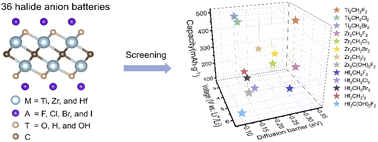Theoretical design of high-performance halogen anion batteries with MXene electrodes: influence of functional groups, metals, and anions†
Abstract
Halogen anion batteries (HABs) are considered emerging and promising alternative technologies for metal-ion batteries due to their high abundance, energy density, environmental friendliness, and safety. But developing suitable electrode materials for HABs is still challenging. Here, by using first-principles calculations, we systemically investigated the adsorption, stability, diffusion, and electrochemical properties of 4 halogen anion (F−, Cl−, Br− and I−) batteries with 9 M2CT2 (M = Ti, Zr, Hf; T = O, H, OH) MXenes. First of all, the electronegativity of the anions and the surface electronic properties of the MXenes significantly affected the adsorption ability. Next, 13 highly stable HAB models were screened from the above 36 models by using ab initio molecular dynamics simulations, and the intrinsic correlations of bond length, bond strength, and stability were established. Based on stable models, we found that the diffusivity of halogen anions on MXenes was better than that of other ions, especially the F ions in Zr2C(OH)2 and Hf2C(OH)2 exhibiting optimal diffusivity with low diffusion energy barriers of 0.095 eV and 0.120 eV, respectively. The electrochemical performance results indicated that the HABs with M2CT2 electrodes showed an excellent theoretical capacity of 488 mA h g−1 (Ti2CH2), an attractive open-circuit voltage of 6.27 V (Hf2C(OH)2), and small voltage changes of 0.02 V (Hf2CH2). Interestingly, the different HABs with H-functionalized MXenes exhibited peculiar open-circuit voltage curves, that is, the voltage increases during discharge, which was determined by the offset of the H functional group, the binding strength between halogen ions and MXenes, and the electronic interaction between halogen anions. In conclusion, this study screens promising electrode materials and provides a theoretical basis for the development of novel HABs.



 Please wait while we load your content...
Please wait while we load your content...